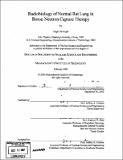| dc.contributor.advisor | Jeffrey A. Coderre. | en_US |
| dc.contributor.author | Kiger, Jingli Liu | en_US |
| dc.contributor.other | Massachusetts Institute of Technology. Dept. of Nuclear Science and Engineering. | en_US |
| dc.date.accessioned | 2008-04-23T14:41:12Z | |
| dc.date.available | 2008-04-23T14:41:12Z | |
| dc.date.copyright | 2006 | en_US |
| dc.date.issued | 2006 | en_US |
| dc.identifier.uri | http://hdl.handle.net/1721.1/41286 | |
| dc.description | Thesis (Ph. D.)--Massachusetts Institute of Technology, Dept. of Nuclear Science and Engineering, 2006. | en_US |
| dc.description | Includes bibliographical references. | en_US |
| dc.description.abstract | Boron Neutron Capture Therapy (BNCT) is a binary cancer radiation therapy that utilizes biochemical tumor cell targeting and provides a mixed field of high and low Linear Energy Transfer (LET) radiation with differing biological effectiveness. This project investigated the radiobiology of normal rat lung in BNCT and measured the relative biological effectiveness factors for the lung. Rat thorax irradiations were carried out with x-rays and neutrons with or without the boron compound boronophenylalanine-fructose (BPA-F). Monte Carlo radiation transport simulations were used to design the rat lung neutron irradiations. Among the neutron beam facilities available for BNCT at the MIT Research Reactor, the thermal neutron beam facility was found to provide a suitable dose distribution for this project. A delimiter was designed and constructed for the rat lung irradiations as a lithiated-polyethylene plate of 1.5 cm thickness with an aperture tapered from 4 to 3 cm in width to expose the lung to the beam and shield adjacent radiosensitive organs. The simulation design was validated with in-phantom measurements using gold foil activation and the dual ion chamber technique. By using a two-field irradiation, a relatively uniform dose distribution could be delivered to the rat lung. The mean lung dose rate was 18.7 cGy/min for neutron beam only irradiation and 37.5 cGy/min with neutrons plus BPA and a blood boron concentration of 18 gg/g. | en_US |
| dc.description.abstract | (cont.) The delimiter designed for rat lung irradiation, and another similar delimiter, along with the animal holding box, all designed in this project, also serve as the apparatus for other small animal irradiations and cell irradiations at the thermal neutron facility at the MIT Research Reactor. An open-flow whole-body plethysmography system with fully automated signal processing programs was developed to non-invasively measure rat breathing rates and lung functional damage after lung irradiation. Noise reduction was carried out against high frequencies beyond the range of rat breathing frequency and large amplitude spikes due to abnormal animal movement. The denoised breathing signals were analyzed using the Fast Fourier Transform with a circular moving block in combination with the bootstrap for noise suppression and to allow estimation of the statistical uncertainty (standard deviation) of frequency measurements. The major frequency of the mean frequency spectrum was determined as the breathing frequency. The mean control breathing rate was 176 ± 13 (7.4%) min' (mean ± SD), and breathing rates 20% (- 3 SD) above the control average were considered to be abnormally elevated. The mean standard deviation of all measurements (n = 4269) was 2.4%. The dose responses of different irradiation groups with breathing rate elevation as the biological endpoint were evaluated with probit analysis. Two response phases of breathing rate elevation were observed as the early response phase (<100 days) and the late response phase (>100 days). The ED50 values for x-rays, neutrons only, and neutrons plus BPA during the early response phase, and neutrons plus BPA during the late response phase, were 11.5 ± 0.4 Gy, 9.2 + 0.5 Gy, 8.7 ± 0.6 Gy and 6.7 ± 0.4 Gy, respectively. | en_US |
| dc.description.abstract | (cont.) The radiobiological weighting factors for the neutron beam (neutrons and photons), thermal neutrons only, %°B dose component during the early response phase, and 10B dose component during the late response phase were 1.24 ± 0.08, 2.2 ± 0.4, 1.4 ± 0.2, and 2.3 + 0.3, respectively. The histological damage to the lung during the late phase was also quantified with a histological scoring system. A set of linear dose response curves with histological damage as the endpoint was constructed. The radiobiological weighting factors for the different dose components were also determined at a degree of lung histological damage corresponding to a median histological score between the baseline (similar to the control) and the maximum. The weighting factors measured, 1.22 ± 0.09 for the thermal neutron beam and 1.9 + 0.2 for the o1B dose component, are consistent with the corresponding weighting factors measured using functional damage. The knowledge gained in these radiobiological studies of the normal rat lung indicates that the lung complications experienced by two patients in the Harvard-MIT clinical trial of BNCT for brain tumors do not appear to be related to the BNCT irradiations. This project is also helpful for evaluating the feasibility of BNCT for lung cancer. | en_US |
| dc.description.statementofresponsibility | by Jingli Liu Kiger. | en_US |
| dc.format.extent | 207 p. | en_US |
| dc.language.iso | eng | en_US |
| dc.publisher | Massachusetts Institute of Technology | en_US |
| dc.rights | M.I.T. theses are protected by
copyright. They may be viewed from this source for any purpose, but
reproduction or distribution in any format is prohibited without written
permission. See provided URL for inquiries about permission. | en_US |
| dc.rights.uri | http://dspace.mit.edu/handle/1721.1/7582 | en_US |
| dc.subject | Nuclear Science and Engineering. | en_US |
| dc.title | Radiobiology of normal rat lung in Boron Neutron Capture Therapy | en_US |
| dc.type | Thesis | en_US |
| dc.description.degree | Ph.D. | en_US |
| dc.contributor.department | Massachusetts Institute of Technology. Department of Nuclear Science and Engineering | |
| dc.identifier.oclc | 213481626 | en_US |

